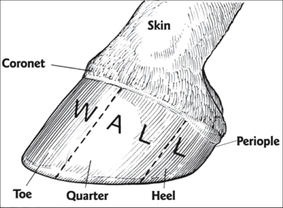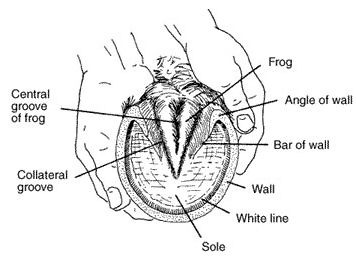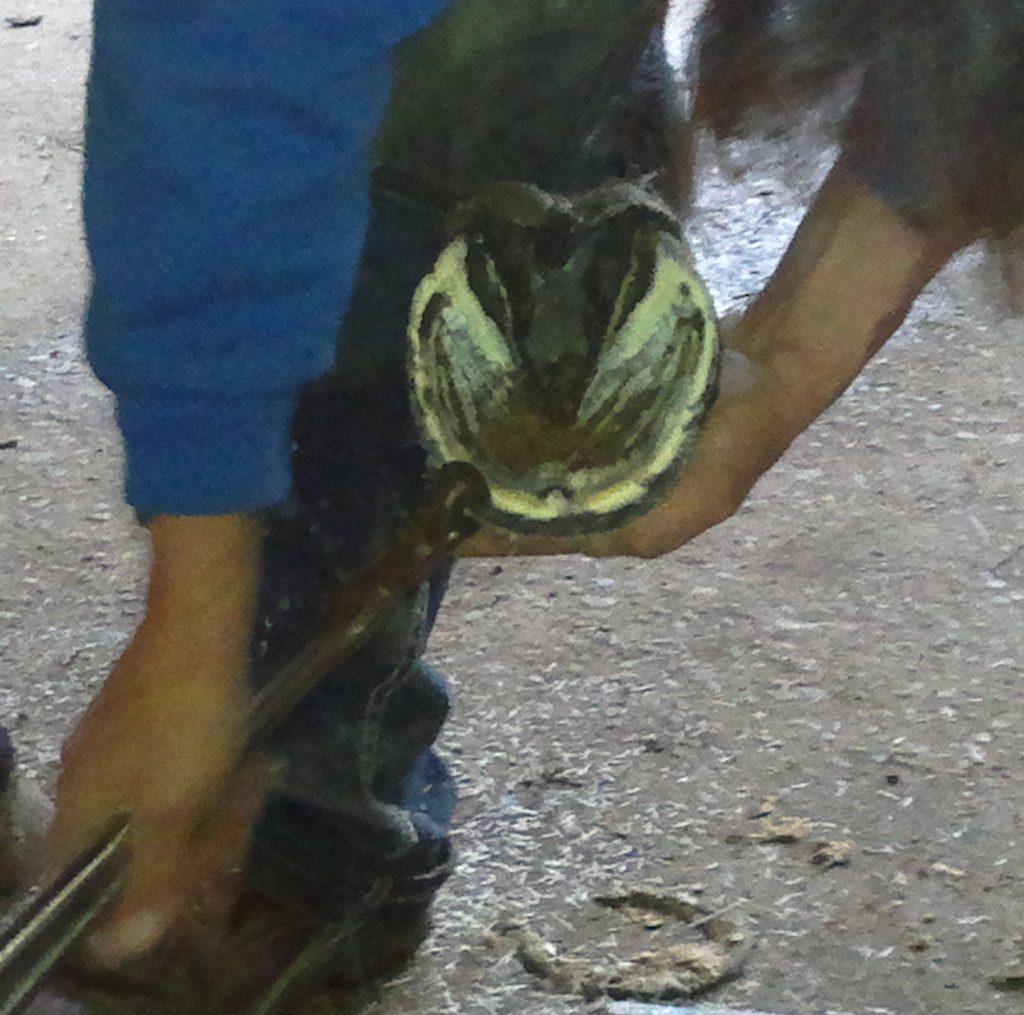Horsemanship Level 4: Foot and Shoeing pt I
For want of a nail, the shoe was lost. For want of a shoe the horse was lost ...
This proverb cautioning us to attend to detail continues to the loss of the battle, but as horse-keepers we don't need to follow the butterfly effect any further. The old saying 'no hoof, no horse' is briefer and just as true. At Level 4 your care for your horse's feet should extend beyond picking them out and knowing when to call the farrier. We want you know:
External structures, care of the foot. Benefits of barefoot vs shoes. Reasons to shoe/reshoe.
This week we'll look at the external structures and care of the foot; next week's blog will cover the pros and cons of shoeing.
First take a peek at this Level 3 post to review the external anatomy of the hoof. For Level 4 you should not only know the parts of the foot, but have a basic idea of how they function. The hoof can be divided into three general parts: wall, frog, and sole.
 Wall. The wall is composed of hard keratin (like fingernails), and contains no nerves. It supports most of the weight of the horse, expanding during the impact of a stride, and contracting when the hoof is lifted. It is covered with a thin shiny layer (stratum externa) that descends from periople (area along the top of the hoof, analogous to our nail cuticle), and protects the hoof from losing or absorbing too much moisture. (Note: some texts refer to the entire coating of the hoof as the periople. You will not be marked incorrect for either definition.) The wall is further divided into toe, quarters, and heels, and the juncture of the insensitive wall with the living tissue of the sensitive laminae is marked by the white line. When picking out hooves it is important to check the white lines for separation or gravelling (small bits of rock working their way into the white lines) which can result in abscesses and other lameness. The hoof grows at a rate of 1/4 to 1/2 inch per month and must be trimmed every four to eight weeks by an experienced farrier. Improper trimming can imbalance the hoof and lead to injury of the tendons, bones or muscles of the leg.
Wall. The wall is composed of hard keratin (like fingernails), and contains no nerves. It supports most of the weight of the horse, expanding during the impact of a stride, and contracting when the hoof is lifted. It is covered with a thin shiny layer (stratum externa) that descends from periople (area along the top of the hoof, analogous to our nail cuticle), and protects the hoof from losing or absorbing too much moisture. (Note: some texts refer to the entire coating of the hoof as the periople. You will not be marked incorrect for either definition.) The wall is further divided into toe, quarters, and heels, and the juncture of the insensitive wall with the living tissue of the sensitive laminae is marked by the white line. When picking out hooves it is important to check the white lines for separation or gravelling (small bits of rock working their way into the white lines) which can result in abscesses and other lameness. The hoof grows at a rate of 1/4 to 1/2 inch per month and must be trimmed every four to eight weeks by an experienced farrier. Improper trimming can imbalance the hoof and lead to injury of the tendons, bones or muscles of the leg. Frog. This V-shaped mass of rubbery cartilage makes contact with the ground during impact and provides shock-absorbtion, traction, and proprioception (feeling) for the otherwise insensitive hoof. Pressure on the frog during impact transfers to the digital cushion which sits level with the bulbs of the heel. This acts a shock absorber for the legs, and a pump that sends blood through the rest of the hoof and lower leg. The frog also expands sideways during impact, pushing out the walls of the hoof and aiding circulation. A healthy frog is essential for a sound horse. Like the wall, it grows continuously, but generally sloughs away naturally. Your farrier may trim sloughing tissue to see the frog condition more clearly, but should not pare it down so much that it no longer touches the ground.
Frog. This V-shaped mass of rubbery cartilage makes contact with the ground during impact and provides shock-absorbtion, traction, and proprioception (feeling) for the otherwise insensitive hoof. Pressure on the frog during impact transfers to the digital cushion which sits level with the bulbs of the heel. This acts a shock absorber for the legs, and a pump that sends blood through the rest of the hoof and lower leg. The frog also expands sideways during impact, pushing out the walls of the hoof and aiding circulation. A healthy frog is essential for a sound horse. Like the wall, it grows continuously, but generally sloughs away naturally. Your farrier may trim sloughing tissue to see the frog condition more clearly, but should not pare it down so much that it no longer touches the ground.- Sole. The surface of the sole is hard, but will compress upwards slightly if pushed, like a suspended ceiling. Although the sole itself is not sensitive, it is fairly thin and the structures underneath are subject to bruising, for example if a horse steps with force on a large stone. A healthy sole is slightly cupped upward, and should not come into contact with the ground in a well-maintained foot. A horse with too aggressive a trim may be sensitive or even become lame if the sole is touching hard ground.
Hooves, whether shod or unshod, should be picked out before and after every ride to remove large stones that could cause bruising, gravel that could cause abscesses, and dirt and manure that could allow the growth of fungus or bacteria in the crevices of the foot. Daily inspection allows you to check for cracks in the walls or heels, deterioration of the frog, or growth of thrush (smelly black goo in the crevices), as well any problems with shoes.
Current and Upcoming Classes
Assessments are coming up on March 13th! Check in with your instructor to make sure you’re ready. If you aren’t currently in classes and would like to do either a Horsemanship, Riding or Mounted Combat assessment be sure to register well in advance. All classes take place at Red Colt Co-op, 12320 No 2 Road, in Richmond.
Mounted Combat Assessments
Sunday 6 March, 1:00 – 4:30pm
cost: $50 for one assessment; $80 for two or more
one assessment included with each 5 or 6 week course
Intermediate Mounted Combat
Sundays 13 Mar – 10 Apr, 1pm – 3pm
cost: $160 + gst
Mounted Combat Fundamentals
Sundays 13 Mar – 10 Apr, 1:30 – 3pm
cost: $120 + gst
Beginner Riding & Horsemanship
Sundays 13 Mar – 17 Apr, 10am – noon
Saturdays 2 Apr - 7 May, 4pm - 6pm
cost: $300 + gst
Riding & Horsemanship Level 2
Sundays 13 Mar – 17 Apr, 10am – noon
Saturdays 2 Apr - 7 May, 4pm - 6pm
cost: $300 + gst
Horsemanship Level 3-4
Sundays 13 Mar – 17 Apr, 10:30 – 11:30am
cost: $130 + gst
Riding Level 3+
Sundays 13 Mar – 17 Apr, noon – 1pm
Saturdays 2 Apr - 7 May, 6pm - 7pm
cost: $200 + gst
Mounted Combat Playday
Sunday 3 April, 1:00 – 4:00pm
cost: $15 + $15 for use of school horse
Free for ground crew & spectators!
